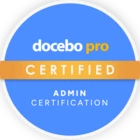I have a stack of videos to upload to a course; repeated failures prompted the following:
- Why the 800MB limit? In a 4K source file world that is very small.
- Any FTP bulk upload site? Rather than one by one.
- Upload fails when laptop sleeps during upload. Not a problem for Box et al.
- What notifications does a user get if new or revised media is uploaded to an existing course?
- What are the supported streaming sites. I see YTube and Vimeo, but what is the other logo?
Thanks
Phil







